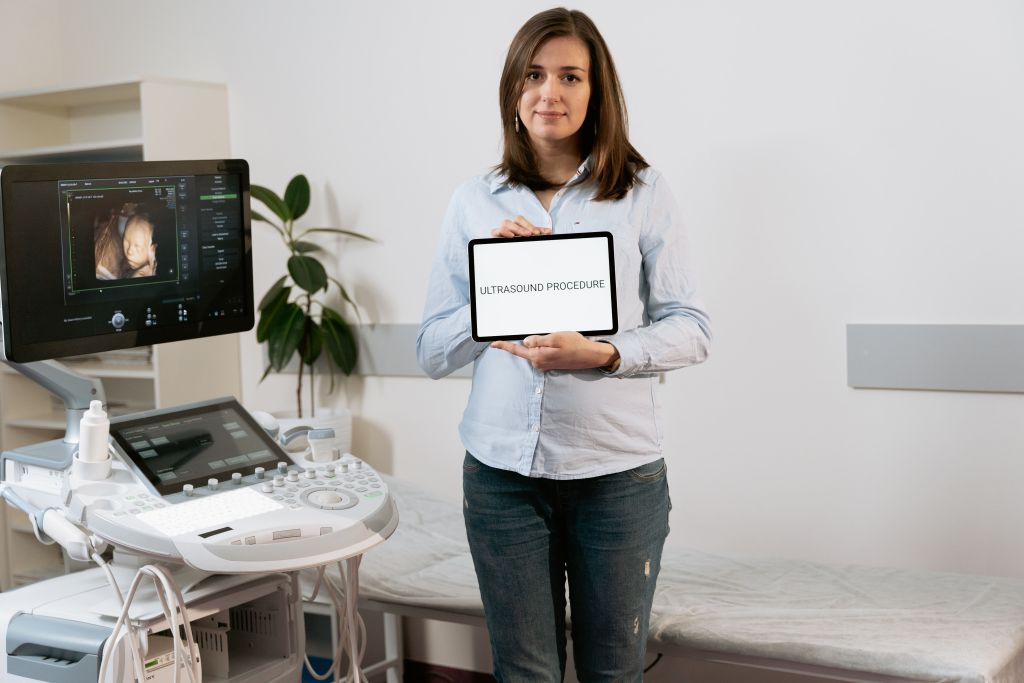ULTRASOUND SERVICES
An ultrasound is an imaging test that uses sound waves to create a picture (also known as a sonogram) of organs, tissues, and other structures inside the body. Unlike x-rays, ultrasounds don’t use any radiation. An ultrasound can also show parts of the body in motion, such as a heart beating or blood flowing through blood vessels.
Fortune Healthcare have two main categories of ultrasounds: pregnancy ultrasound and diagnostic ultrasound

Pregnancy ultrasound in Fortune Healthcare: This is used to look at an unborn baby. The test can provide information about a baby’s growth, development, and overall health.
Diagnostic ultrasound in Fortune Healthcare: This is used to view and provide information about other internal parts of the body. These include the heart, blood vessels, liver, bladder, kidneys, and female reproductive organs.
Other names: sonogram, ultrasonography, pregnancy sonography, fetal ultrasound, obstetric ultrasound, diagnostic medical sonography, diagnostic medical ultrasound
Diagnostic ultrasound service in Fortune used for:
- Find out if blood is flowing at a normal rate and level.
- See if there is a problem with the structure of your heart.
- Look for blockages in the gallbladder.
- Check the thyroid gland for cancer or non-cancerous growths.
- Check for abnormalities in the abdomen and kidneys.
- Help guide a biopsy procedure. A biopsy is a procedure that removes a small sample of tissue for testing.
- In women, diagnostic ultrasound may be used to:
- Look at a breast lump to see if it might be cancer. (The test may also be used to check for breast cancer in men, though this type of cancer is far more common in women.)
- Help find the cause of pelvic pain.
- Help find the cause of abnormal menstrual bleeding.
- Help diagnose infertility or monitor infertility treatments.
- In men, diagnostic ultrasound may be used to help diagnose disorders of the prostate gland.
Ultrasound test in FORTUNE Healthcare used for
An ultrasound can be used in different ways, depending on the type of ultrasound and which part of the body is being checked.
A pregnancy ultrasound is done to get information about the health of an unborn baby. It may be used to:
- Confirm that you are pregnant.
- Check the size and position of the unborn baby.
- Check to see you are pregnant with more than one baby.
- Estimate how long you have been pregnant. This is known as gestational age.
- Check for signs of Down syndrome, which include thickening in the back of the baby’s neck.
- Check for birth defects in the brain, spinal cord, heart, or other parts of the body.
- Check the amount of amniotic fluid. Amniotic fluid is a clear liquid that surrounds an unborn baby during pregnancy. It protects the baby from outside injury and cold. It also helps promote lung development and bone growth.
WHY DO I NEED A ULTRASOUND
You may need an ultrasound if you are pregnant. There is no radiation used in the test. It offers a safe way of checking the health of your unborn baby.
You may need diagnostic ultrasound if you have symptoms in certain organs or tissues. These include the heart, kidneys, thyroid, gallbladder, and female reproductive system. You may also need ultrasound if you are getting a biopsy. The ultrasound helps your health care provider get a clear image of the area that is being tested.
For appointment contact today, We have the latest technology & Experienced Technician for your best result
WHAT HAPPENS DURING A ULTRASOUND
An ultrasound usually includes the following steps:
- You will lie on a table, exposing the area that’s being viewed.
- A health care provider will spread a special gel on the skin over that area.
- The provider will move a wand-like device, called a transducer, over the area.
- The device sends sound waves into your body. The waves are so high pitched that you can’t hear them.
- The waves are recorded and turned into images on a monitor.
- You may be able to view the images as they are being made. This often happens during a pregnancy ultrasound, allowing you to look at your unborn baby.
- After the test is over, the provider will wipe the gel off your body.
- The test takes about 30 to 60 minutes to complete.
- In some cases, a pregnancy ultrasound may be done by inserting the transducer into the vagina. This is most often done early in pregnancy.
The preparations will depend on which type of ultrasound you are having. For ultrasounds of the abdominal area, including pregnancy ultrasounds and ultrasounds of the female reproductive system, you may need to fill up your bladder before the test. This involves drinking two to three glasses of water about an hour before the test, and not going to the bathroom. For other ultrasounds, you may need to adjust your diet or to fast (not eat or drink) for several hours before your test. Some types of ultrasounds require no preparation at all.
Your health care provider will let you know if you need to do anything to prepare for your ultrasound.
ARE THERE ANY RISKS TO THE TEST in FOrtune
There are no known risks to having an ultrasound. It is considered safe during pregnancy.



WHAT DO THE RESULTS MEAN
If your pregnancy ultrasound results were normal, it doesn’t guarantee you’ll have a healthy baby. No test can do that. But normal results may mean:
- Your baby is growing at a normal rate.
- You have the right amount of amniotic fluid.
- No birth defects were found, though not all birth defects will show up on an ultrasound.
- If your pregnancy ultrasound results were not normal, it may mean:
- The baby is not growing at a normal rate.
- You have too much or too little amniotic fluid.
- The baby is growing outside the uterus. This is called an ectopic pregnancy. A baby can’t survive an ectopic pregnancy, and the condition can be life threatening for the mother.
- There is a problem with the baby’s position in the uterus. This could make delivery more difficult.
- Your baby has a birth defect.
- If your pregnancy ultrasound results were not normal, it doesn’t always mean your baby has a serious health problem. Your provider may suggest more tests to help confirm a diagnosis.
- If you had diagnostic ultrasound, the meaning of your results will depend on which part of the body was being looked at.
- If you have questions about your results, talk to your health care provider.
WHAT IS THE DIFFERENCE BETWEEN A 3D ULTRASOUND AND A 4D ULTRASOUND
For ultrasounds during pregnancy, the traditional ultrasound is a two-dimensional (2D) image of your unborn baby. 2D ultrasound produces outlines and flat-looking images, which allows your healthcare provider to see your baby’s internal organs and structures.
Three-dimensional (3D) ultrasound allows the visualization of some facial features of your baby and possibly other body parts such as fingers and toes. Four-dimensional (4D) ultrasound is 3D ultrasound in motion. Providers rarely use 3D or 4D fetal ultrasound imaging for medical purposes, though it can be useful in diagnosing a facial or skeletal issue. They do, however, use 3D ultrasound for other medical purposes, such as evaluating uterine polyps and fibroids.
While ultrasound is generally considered to be safe with very low risks, the risks may increase with unnecessary prolonged exposure to ultrasound energy or when untrained users operate an ultrasound machine. Because of this, the U.S. Food and Drug Administration (FDA) advises against getting a 3D ultrasound for non-medical reasons such as for “keepsake” moments or entertainment.
WHO PERFORMS AN ULTRASOUND in fortune healthcare
A doctor or a healthcare provider called an ultrasound technician or sonographer performs ultrasounds. They’re specially trained to operate an ultrasound machine properly and safely.
It’s important to always have your ultrasound performed by a medical professional and in a medical facility.



HOW DO I PREPARE FOR A ULTRASOUND
The preparations will depend on the type of ultrasound you’re having. Some types of ultrasounds require no preparation at all.
For ultrasounds of the pelvis, including ultrasounds during pregnancy, of the female reproductive system and of the urinary system, you may need to fill up your bladder by drinking water before the test.
For ultrasounds of the abdomen, you may need to adjust your diet or fast (not eat or drink anything except water) for several hours before your test.
In any case, your healthcare provider will let you know if you need to do anything special to prepare for your ultrasound. They may give you instructions during an appointment or when scheduling your ultrasound. Instructions may also be available in your electronic medical records if you use such a system.
WHAT HAPPENS DURING A ULTRASOUND
Preparation for an ultrasound varies depending on what body part you’ll have scanned. Your provider may ask you to remove certain pieces of clothes or change into a hospital gown.
Ultrasounds that involve applying the transducer (probe) over your skin (not in your body), follow these general steps:
You’ll lie on your side or back on a comfortable table.
The ultrasound technician will apply a small amount of water-soluble gel on your skin over the area to be examined. This gel doesn’t harm your skin or stain your clothes.
The technician will move a handheld transducer or probe over the gel to get images inside your body.
The technician may ask you to be very still or to hold your breath for a few seconds to create clearer pictures.
Once the technician has gotten enough images, they’ll wipe off any remaining gel on your skin and you’ll be done.
An ultrasound test usually takes 30 minutes to an hour. If you have any questions about your specific type of ultrasound, ask your healthcare provider.
IS A ULTRASOUND PAINFUL
Ultrasounds that are performed externally (over your skin) are generally not painful. You won’t feel the sound waves that ultrasound uses. If you have to have a full bladder for the procedure, it may be uncomfortable. It may also be uncomfortable to lay on the exam table if you’re pregnant.
Ultrasounds that go inside body cavities, such as your vagina or rectum, may be uncomfortable, but they shouldn’t hurt.
ARE ULTRASOUNDS SAFE
Yes, research to date has largely shown ultrasound technology to be safe with no harmful side effects. Ultrasound doesn’t use radiation, unlike some other medical imaging tests, such as X-rays and CT scans.
Still, all ultrasounds should be done by a professional who has training in using this specialized technology safely.
WHEN SHOULD I KNOW THE RESULTS OF MY ULTRASOUND in Fortune Healthcare
The time it takes to get your results depends on the type of ultrasound you get. In some cases, such as prenatal ultrasound, your provider may analyze the images and provide results during the test.
In other cases, a radiologist, a healthcare provider trained to supervise and interpret radiology exams, will analyze the images and then send the report to the provider who requested the exam. Your provider will then share the results with you or they may be available in your electronic medical record (if you have an account set up) before your provider reviews the results.
WHAT CONDITIONS CAN BE DETECTED BY ULTRASOUND
Ultrasound can help providers diagnose a wide range of medical issues, including:
- Abnormal growths, such as tumors or cancer.
- Blood clots.
- Enlarged spleen.
- Ectopic pregnancy (when a fertilized egg implants outside of your uterus).
- Gallstones.
- Aortic aneurysm.
- Kidney or bladder stones.
- Cholecystitis (gallbladder inflammation).
- Varicocele (enlarged veins in the testicles).




